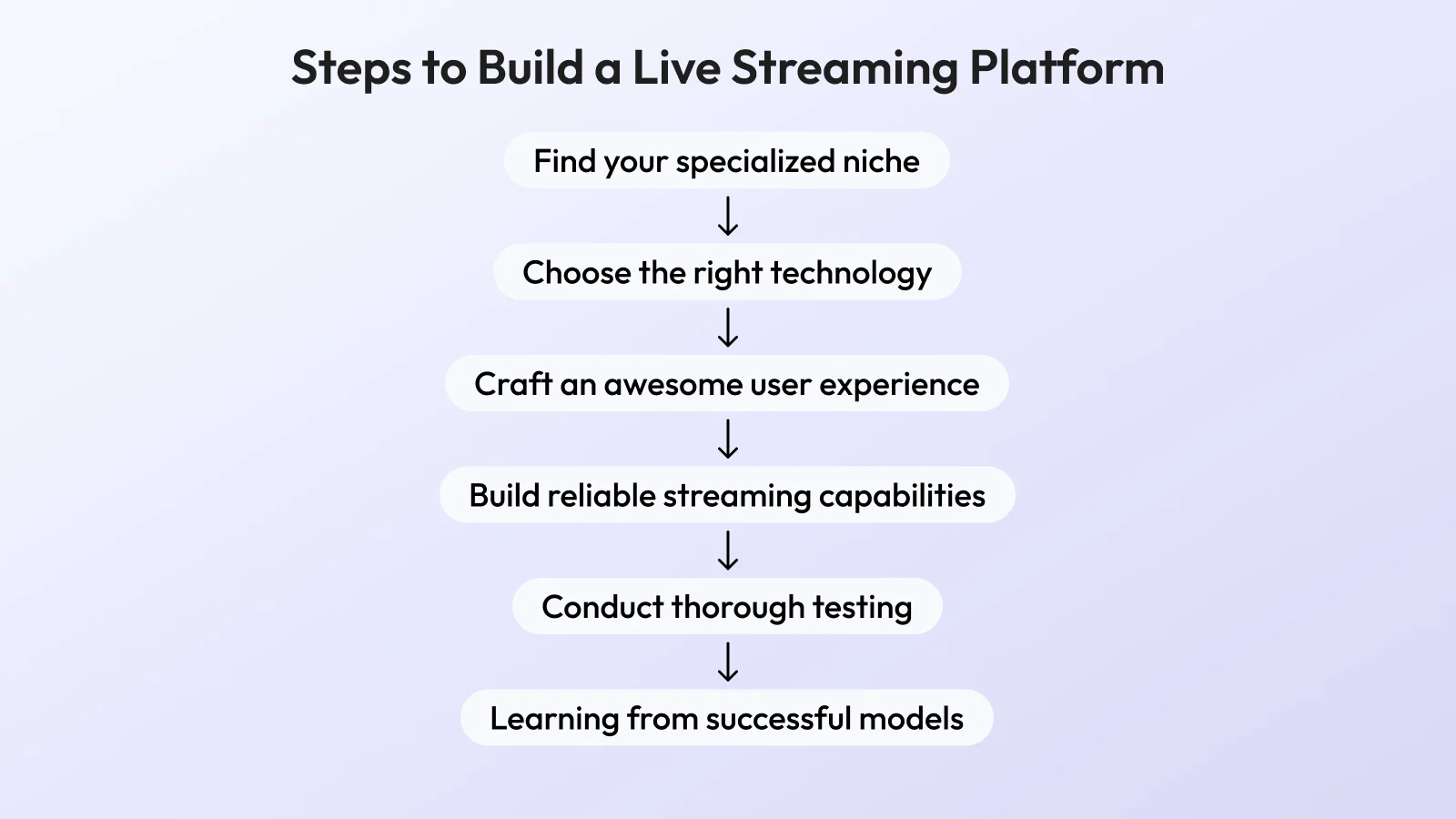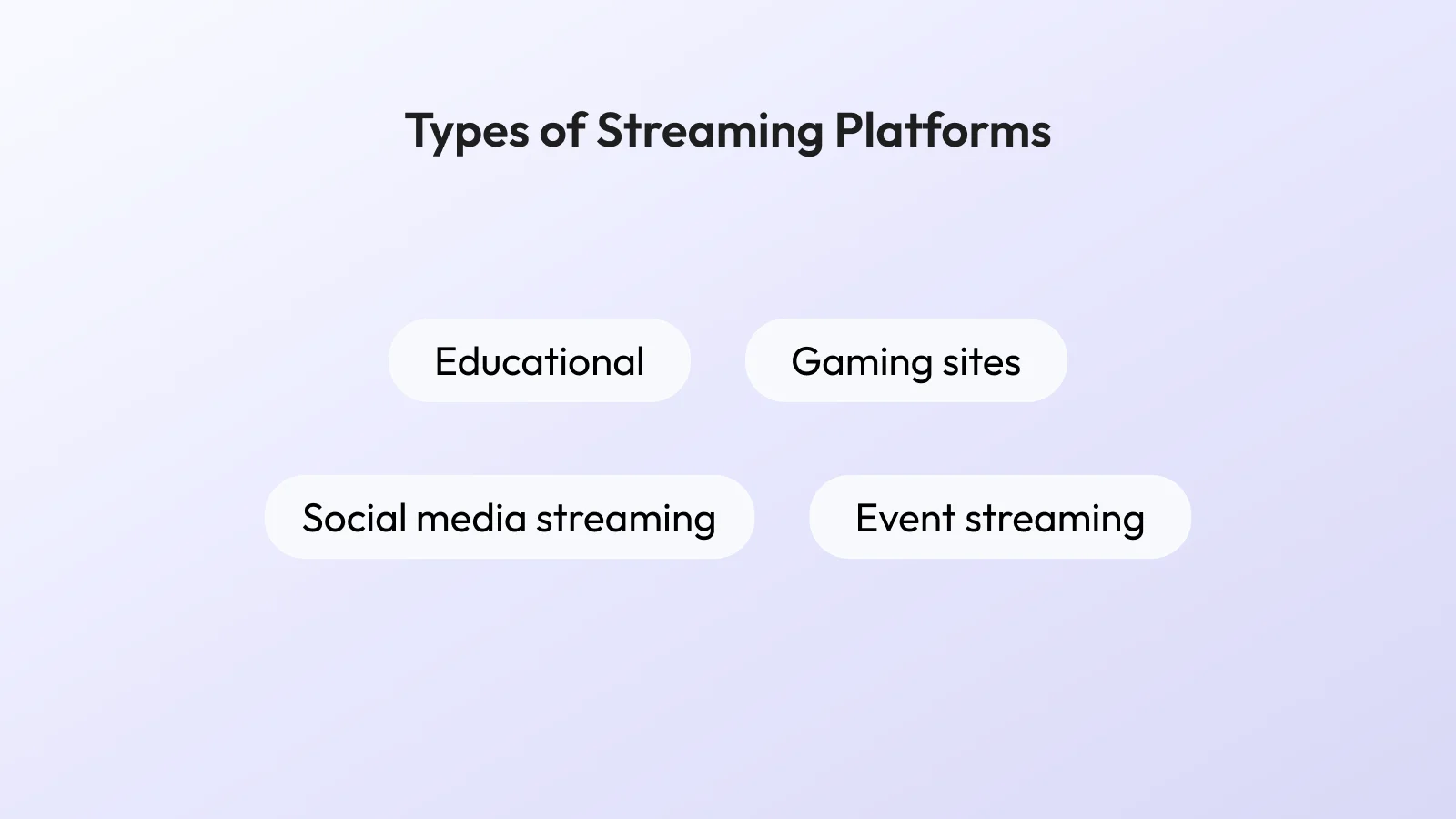Live streaming has drastically changed how consumers keep an eye on content today since it facilitates real-time interaction between artists and viewers. It is sure to be really enjoyable and rewarding to create your own live-streaming website. In this tutorial, we’ll define live-streaming websites, list the process of creating them, and show the immense range and diversity of streaming websites available.
We will also cover the most important features, including custom software development costs, and some main ways of monetizing your live-streaming website.
What Constitutes a Live Streaming Platform?
The first step when you wonder how to create a streaming platform is to define it. Streaming websites are dynamic spaces where users may communicate with their viewers in real time via video.
Take Twitch, for example. What started as something primarily about games has grown to include cooking, music, and even art. Its stunning flexibility says everything about how the platform of live streaming enables artists to transition easily from one hobby to another and from one audience to another.
Live streaming invites participation from the audience with the action since the audience can comment and pose questions as the events unfold in real-time. The interactivity allows producers to react to the audience’s response, creates a more significant connection, and establishes loyalty.
Live streaming on Twitch and YouTube Live is an essential channel for creators to develop successful communities in the present day. They make individual viewers a part of a collective experience and relentlessly navigate the infinite livestream possibilities to interact and converse at a more intimate level.

The Market Potential of Live Streaming Solutions
The opportunity in live streaming is enormous, with the potential to dominate the market, valued at more than $800 billion by 2025, in the process making room for new players. This is supplemented by the increasing popularity of virtual events, online concerts, web-based learning, and other such applications, all of which gained traction because of the social distancing directives given during the COVID-19 pandemic, which made live streaming a new phenomenon.
The pandemic gave birth to virtual events in 2020, and thus, platforms like Hopin went mainstream, with event planners seeking solutions to livestream anything from concerts to conferences. The shift unveiled the pressing need for decent solutions to live streaming.
Key Steps to Getting Your Own Live Streaming Service Established
Creating a live-streaming platform is a thrilling endeavor that needs to be planned and executed. Should you be ready to begin, the following are the key steps that will bring you from your idea to launching a successful endeavor.

=> Find your specialized niche
You begin with a vision of who you would want to engage. Do you want to engage gamers who would want the latest gaming tactics, instructors who want to engage students in real-time, or sports enthusiasts who want to make exercise fun? Identification of your niche is very important; it helps you to better design your platform features and promotions. It helps you build a platform that aligns with what your users need so that you can have the appropriate users right from the start.
=> Choose the right technology
Next, consider your technological approach. Are you going to build a completely custom platform, or would you rather rely on existing solutions like Wowza or Vimeo? This is a very important choice because it will have a great impact on your development timeline and budget. Building from scratch allows flexibility and the ability to innovate, but it requires a longer development phase. The choice is very important and should be considered with respect to your goals.
=> Craft an awesome user experience
Having clearly identified your niche and the choice of technology, shift now to the user experience. This is the linchpin that keeps users well involved; an intuitively built and well-designed interface provides the key. Make their navigation through the system a cinch and ensure the repeatability of such processes in sight by encouraging viewers to do it time and over again. Good experience helps in positive engagement and developing loyalties among its end-users who find comfort in being on your platform.
=> Build reliable streaming capabilities
Second, build the technical backbone of your service: the streaming itself. Seamless video and audio without interrupting are not a factor of negotiation. One more thing to consider would be the integration of RTMP, or Real-Time Messaging Protocol, to smoothly communicate with the broadcast application to the user’s end in real-time. So, to ensure that everything will stream perfectly, invest in solid infrastructure with several viewer loads. As is usually said, quality deserves to be delivered by a high-quality method.
=> Conduct thorough testing
Before you go live with your platform, serious testing has to be done. Testing is an important step in terms of finding any technical problem that may hamper performance. Extensive testing will grant you the ability to bug out all glitches and blemishes so that, at the time of the release, everything works perfectly. Do not be afraid to ask for user feedback because, during this stage, real insights and suggestions come in, which would lead to more refinements. A polished product will contribute to success.
=> Learning from successful models
The majority of big online learning sites work on the same principles, and it is clear that interactivity is the secret to holding users’ attention. Follow these important steps to develop a live-streaming site that not only meets but exceeds your users’ expectations. Live-streaming has a lot of potential.
With a proper plan, your site can be both popular and user-friendly.
Types of Streaming Platforms
There are several types of live streaming platforms, each tailored to specific individuals and uses. Here’s a rundown of the leading categories:

=> Gaming sites: Twitch and Mixer
These gaming websites were created with gamers in mind and feature tools like live chat, donation buttons, and live streaming gameplay to the viewers, including popular puzzle games like Pokedoku. These have formed close-knit, active communities around shared interests.
=> Social media streaming: Instagram Live and Facebook Live
These two websites enable users to interact immediately with their viewers. They offer influencers and general users a platform to share moments in real-time, which allows them to interact more with their viewers.
=> Educational: Teachable and Coursera
Both websites are concerned with education and use live streaming as part of teaching. Instructors have a chance to teach in real-time, allowing students to learn actively and enhance their learning experience.
=> Event streaming: Eventbrite
It is a website that streams events live, e.g., workshops and conferences. It helps to reach more people so that anyone from any corner of the world can watch these events, making them more accessible.
These various genres indicate just how far live streaming can go, meeting various needs and desires online.
Features That Need to Be Included in a Live Streaming Website
In order to survive the competitive live streaming business, your website needs to include features that enhance users’ experiences and increase engagement:
User registration: Personalizes user experiences by allowing users to create a profile. It compels the users to subscribe to their favorite streamers and receive personalized suggestions.
Live chat: Provides you with a chance for live communication between viewers and content creators, maximizing community engagement and making viewers feel appreciated.
High-quality streaming: Allows high-definition video with adaptive streaming according to different internet speeds, enabling seamless, uninterrupted viewing.
Multiplayer functionality: Gaming platforms require this feature so that the users can play and compete as a group. It enables interaction with multiplayer games and socializing.
Analytics dashboard: It makes creators aware of how viewers interact and how they are engaging, and thus, they can optimize their strategy and create better content.
Services like YouTube Live are just some of the examples that illustrate how such features work. These allow creators to interact with their audiences through live chat and use analytics to plan content. Such functionality on your site allows it to succeed in the live-streaming market.
Financial Overview of How to Create a Live Streaming Website
Creating a live-streaming website costs, depending on several factors:
Development strategy. Development from scratch can be $50,000 to $200,000 or more, depending on complexity.
Hosting and infrastructure. Hosting for good streaming will be between $500 and $5,000 a month, depending on traffic.
Maintenance and upgrades. Maintenance and upgrades on an ongoing basis will be between $1,000 and $10,000 per year.
The majority of startups follow a Minimum Viable Product (MVP) strategy in order to validate their idea. For instance, a fitness streaming website can have basic features and keep adding more depending on what the users give as feedback so that they do not waste money and are able to validate the idea.
Making Money From a Live Streaming Platform
Live-streaming platforms make money in several ways. They have models where the audience pays monthly for additional content. A good example is Patreon. Additionally, the websites put up ads during their streams. A good example is YouTube. Ads generate a lot of revenue. Also, the audience directly pays the creators, and Twitch makes this popular. This is where donations and tips fit in. Websites partner with brands to make sponsored events or content. This assists them in earning money from their big following. They also sell merch creator content. This assists in making extra funds. For instance, Patreon assists creators in providing special content to patrons. This assists in generating constant income and creating a devoted fan base.

Wrapping Up
A live-streaming platform is an awesome idea. Choose your audience, add the key features, and find several revenue streams, and you will be confident in how to create a live streaming website that resonates with people. There are so many opportunities, and with a solid plan, your live-streaming platform can revolutionize the way people consume content. So, get ready and embark on your live-streaming journey.


